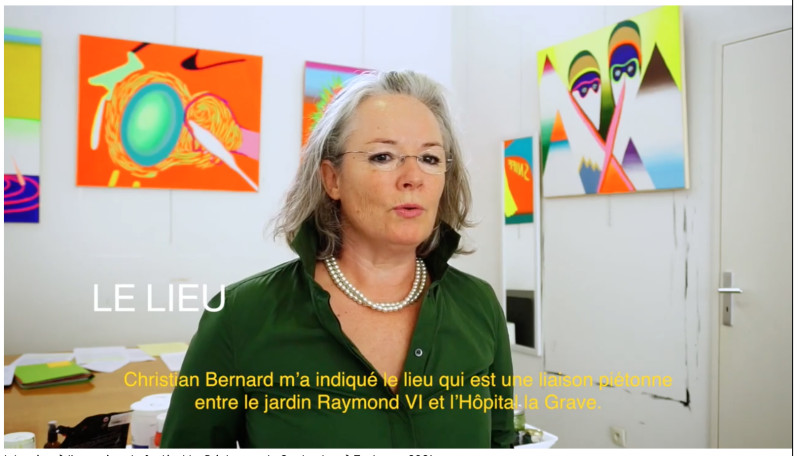Entretien
Françoise-Aline Blain 2017

Virginie Loze creates a world filled with unsettling hybrid creatures caught in comical situations. Her outlook on the world is conveyed through the prism of fantasy and subversion. Her uncompromising brand of humour is reminiscent of the caricatures and comics of underground culture. The images she produces shed light on the threats that challenge individuals and the compromises to their integrity. These images are rooted in today’s social, political and environmental concerns. The artist started out with simple line drawings in various formats, to which she then added fragments of projected videos. Her later use of dry pastel on larger formats enabled her to broaden the range of her narrative apparatus. She currently uses acrylic paint on canvas. In addition to these works, Loze is also known for her commissioned site-specific monumental murals.
Her bold and spontaneous linework brings grotesque composite creatures to life. From the worlds thus created, lyrical metaphors of personal and universal situations arise. Guided by what is conscious and repressed, these ambiguous figures materialise in dual and enigmatic images. Captured in these meticulous compositions, they act as searing allegories, each of which is as puzzling as dream images and heuristic visions.
Virginie Loze
Translated by Lucy Pons, 2022
Entretien
Françoise-Aline Blain 2017
Virginie Loze
Jérôme Carrié 2019
Un écosystème en région. L’artiste au centre
Marianne Derrien 2018
À propos du travail de Virginie Loze
Cendrine Krempp 2012
Virginie Loze, dessine-nous un mouton noir
William Gourdin 2008
Fantômes en réserve
Catherine Macchi 2005
Je me souviens
Virginie Loze

Heike Aumüller, Roger Ballen, John Bock, Olaf Breuning, Maurizio Cattelan, Luigi Colani, Georganne Deen, Zush Evru, Guo Fengyi, Fra Angelico, Sam Friedman, Gelitin, Peter Halley, Uwe Henneken, les tablas Huicholes, Qasim ibn’Ali, Wassily Kandinsky, Solange Knopf, Joel Kyack, Les Lalanne, Kris Lemsalu, Eugène Leroy, Le Livre des Rois persans, Paul McCathy, Damien Michaels, Mu’in Musavvir, Jean Pierre Nadau, Pablo Picasso, Pavel Pepperstein, Raymond Pettibon, Bashdan Qara, Jorge Queiroz, Karine Rougier, Park Kyung Ryul, Jim Shaw, Friedrich Schröder Sonnenstern, Sorolla, Saul Steinberg, Jessica Stokholder, Ryan Trecartin, Alecksandra Waliszewska, Gary Webb, Peter Witkin
Les travailleurs de la mer, Victor Hugo
Outrage public à la pudeur, Tom Sharpe
L’herbe rouge, Boris Vian
Les saisons, Maurice Pons
L’inspecteur des caveaux, Erick McCormack
Effractions, Joy Williams
L’étage des morts, Hugues Pagan
Le Saule, Hubert Selby Junior
Le portier, Reynaldo Arenas
Une œuvre déchirante d’un génie renversant, Dave Eggers
La grande garde, Antoine Sénanque
Mort à crédit, Louis Ferdinand Céline
Eldorado 51, Marc Trillard
Federico Fellini, Alejandro Jodorowsky, Peter Watkins, Fernando Arrabal, Raymond Depardon, Claude Lelouch, Jean-Luc Godard parce qu’il est à la fois : voyeur et pudique, vif et atone, moqueur et sacralisateur, inventif et mimétique, énigmatique et évident, politique et asocial, absurde et intelligent, trivial et métaphysique, sensuel et intelligent, référencé et drôle, rouge et bleu et en camaïeu, personnel et universel, proverbial et anodin, jubilatoire et frustrant, décalé et concentré.
Le grand tour, Jérôme Le Maire
Système K, Renaud Barret
Honeyland, Tamara Kotevska et Ljubomir Stefanov
Pour Sama, Waad Al Kateab et Edward Watts
Tarnation, Jonathan Caouette
Human flow, Ai Wei Wei
Men and chicken, Anders Thomas Jensen
Pompeï, Anna Falguères et John Shank
La grande bouffe, Marco Ferreri
The fall, Tarsem Singh
Eraserhead, David Lynch
El topo, Alejandro Jodorowsky
Les harmonies Werckmeister, Béla Tarr
Brigitte Fontaine, Serge Gainsbourg, Barbara, Françoise Hardy
« La culture est la règle, l’art est l’exception » Jean-Luc Godard.
« Ce que l’on est incapable de changer, il faut au moins le décrire » Rainer Werner Fassbinder
« Si vous voulez le pouvoir, un moment viendra où vous devrez propager des fictions, si vous voulez la vérité un moment viendra où il vous faudra renoncer au pouvoir » Yuval Noah Harari « Sapiens » « Homo Deus »
« Une œuvre d’art n’est supérieure que si elle est en même temps un symbole et l’expression exacte d’une réalité » Guy de Maupassant
« Notre inconscient est traversé par des archétypes des grands schémas primitifs qui appartiennent à l’aube de l’espèce humaine. Les mythes, les légendes, les peurs primitives ; quand un fait, un tableau nous rappelle ces drames, nous sommes alors touchés en profondeur et même submergés par une émotion qui nous dépasse et qui appartient à toute l’humanité » Carl Gustav Jung